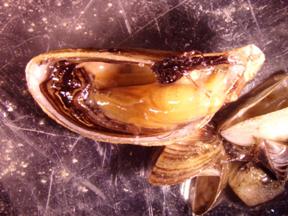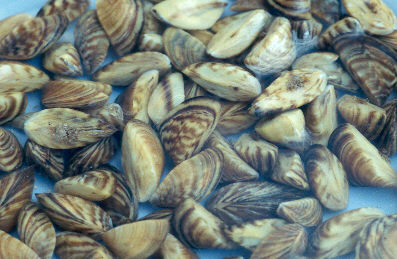Nutrition
Zebra Mussels are filter feeders having both inhalant and
exhalant siphons, which are located between posterior margins of
the two shells. They draw water into their bodies and filter,
using their large gills, out
most of the phytoplankton, bacteria, protozoans, zebra mussel
veligers,
other microzooplankton, and silt. These creatures are
capable of filtering about one liter of water per day.
Zebra
mussels feed on all types of algae except they avoid consuming
blue-green algae. The growth of blue-green algae is extremely
large in areas where the Zebra Mussel is found.
The large
increase in the Zebra Mussel population has also affected
ecosystems in many other ways. For example, in the Great Lakes
and Hudson River, the biomass of phytoplankton has significantly
decreased since the arrival of the Zebra Mussel.
Their invasion has also decreased the abundance of Diatoms.
Reduction in zooplankton, such as the water flea, which is indirectly affected through the reduction of phytoplankton, biomass may cause increased competition with planktivorous fish. The presence of Zebra Mussels in an aquatic ecosystem cause the entire ecosystem to transform.
How do they do all of these things? Check out the adaptation page to answer your questions!


